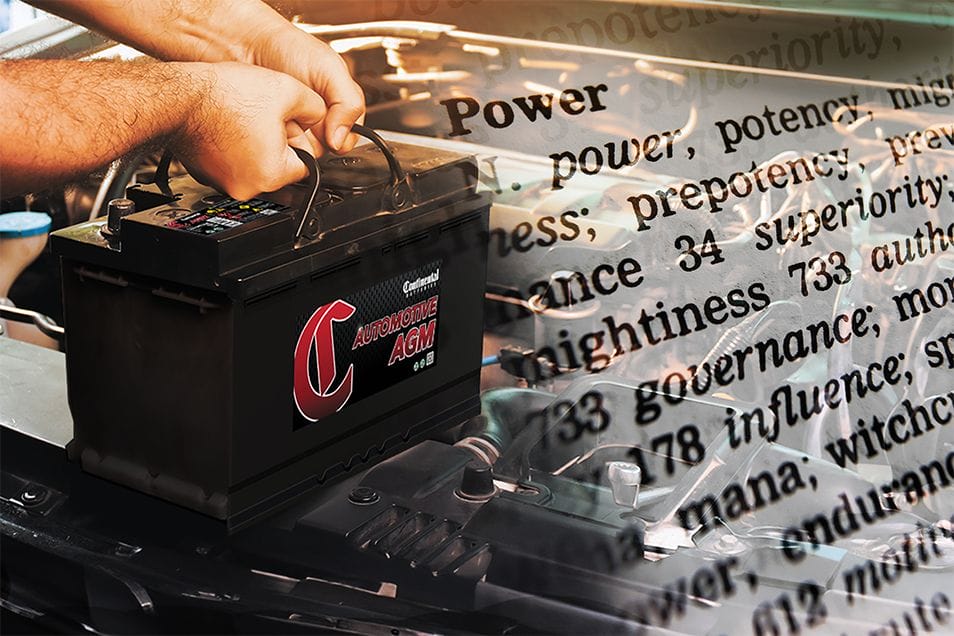
A battery is an electrochemical device that stores and delivers energy. Energy is chemically stored in the battery, and when the battery terminals are connected through a resistive load, electrical energy passes through the circuit.
But the language and shorthand around batteries can be confusing. Consider this your glossary and quick reference guide for battery terminology — from A(GM) to V(oltage).
Batteries by Chemistry
Different types of batteries can be categorized by chemistry — or what’s inside that creates an electrical charge. The primary types of vehicle batteries are lead-acid and lithium-ion. Within these broader categories, there are some terms to keep in mind.
Lead Acid Batteries
Flooded Lead-Acid (FLA). Flooded (or wet cell) batteries contain liquid that is a mixture of sulfuric acid and distilled water. Flooded batteries release gas as they discharge and need to be placed upright to prevent leaking. Flooded batteries also need to be refilled with distilled water from time to time to remain in good working condition.
Absorbed Glass Mat (AGM). Sealed, non-spillable, maintenance-free valve-regulated batteries that use very fine fiber boron-silicate glass mats between the plates. They are also called starved electrolyte batteries. AGM batteries will not leak or spill and can survive most freezes.
Gel. A gel battery design is typically a modification of the standard FLA. A gelling agent is added to the electrolyte to reduce movement inside the battery case. Many gel batteries also use one-way valves in place of open vents. This helps the normal internal gasses to recombine back into water in the battery, reducing gassing. Gel cell batteries are non-spillable, even if they are broken. Gel cells must be charged at a lower voltage (C/20) than flooded or AGM batteries to prevent excess gas from damaging the cells. Fast charging them on a conventional automotive charger may permanently damage a gel battery.
Enhanced Flooded Battery (EFB). As the name implies, an EFB battery is an enhanced version of the conventional FLA battery. EFBs have a liquid sulfuric acid electrolyte that creates electricity when it comes into contact with the lead plates.
Although it’s still a wet cell battery, EFB is sealed and uses a poly fleece material to line the lead plates inside the battery. This offers additional protection for the lead plates and a more consistent energy flow than traditional batteries. EFBs also have carbon additives in the lead plates and a specially designed grid structure that transfers electrons more effectively. All these features make EFBs durable and reliable.
Lithium-Ion (Li-Ion). A type of rechargeable battery known for its high energy density, lightweight, and long life, lithium batteries have been gaining in popularity across all types of vehicle applications.
The battery itself contains a cathode, anode, electrolyte, separator, and a positive and negative current collector. The cathode and anode store the lithium. The job of the electrolyte is to carry the positively charged lithium ions from the anode to the cathode and back again through the separator.
As the lithium moves along, it creates free electrons in the anode area; this creates a positive charge at the positive current collector. The electrical current moves from the current collector through the car and then back to the negative current collector.
Lithium typically costs more upfront than lead-acid counterparts but has a longer lifespan.
SLI vs. Deep Cycle Batteries
Vehicle batteries can be further broken down into categories based on their construction.
Starting, Lighting and Ignition (SLI). Starting batteries (or SLI) are commonly used to start and run engines. Engine starters need a large starting current for a short time. Starting batteries typically have a larger number of thin plates, giving them the maximum surface area to generate current.
An automotive battery is an SLI battery. Its plates are designed to deliver maximum power for a short duration. Starting a car typically discharges an SLI battery only 1% to 3%. Once the engine is going, the alternator provides the continued energy supply to keep the vehicle moving and recharges the battery.
Deep Cycle. Electric vehicles and many industrial applications make extensive use of deep-cycle batteries, useful for any time you need the battery to supply all the operating power for a vehicle or other device. Thicker lead plates allow deep-cycle batteries to provide longer sustained amounts of electricity but less power compared to traditional batteries.
You’ll find these batteries in recreational vehicles, boats, golf carts and electric vehicles, such as medical carts or electric bikes. Deep-cycle batteries are a fit for vehicles with heavy electronic loads that require constant battery power.
Battery Terms to Know (from A to V)
These terms will help you understand how your battery works — and what to look for when shopping for a replacement.
Amp Hours (Ah). A rating that tells you the amount of charge a battery can deliver in one hour. A typical Ah for a car battery is between 75 and 120.
Battery Box. Hard case to hold and protect batteries from excessive vibration or movement.
Battery Chargers. External power sources used to replenish the energy in your vehicle’s battery, ensuring it’s always ready for the next trip. They can be small and portable for a single vehicle or heavy-duty units that can handle the demands of a commercial fleet.
Trickle chargers and smart chargers can provide a steady source of power for batteries sitting for long periods of time. This reduces self-discharge and guards against overcharging.
Cell. Electrochemical unit used to generate or store electrical energy. A 12V lead-acid battery contains six separate cells at two volts each.
Cold Cranking Amps (CCA). The amount of power supplied by your battery when starting your vehicle on a really cold day (0 degrees Fahrenheit). The definition by Battery Council International (BCI) is the discharge load, in amperes, that a fully charged battery, at 0 degrees Fahrenheit, can deliver for 30 seconds and maintain a voltage of 1.2 volts per cell or higher.
Other similar measurements include:
- CA (Cranking Amps) or MCA (Marine Cranking Amps), measured at 32°F (0°C)
- HCA (Hot Cranking Amps), measured at 80°F (26.7°C)
Corrosion. Oxidation of metal terminals on the surface of a battery, usually as a greenish or white powdery buildup. Corrosion happens when the electrolyte (sulfuric acid) releases hydrogen gas. As hydrogen gas collides with the air and moisture, the chemical reaction causes corrosion. This can occur when the battery is damaged, overcharged or stored improperly for an extended time, and it can affect the performance and overall lifespan of the battery.
Cycle Life: The number of complete charge-discharge cycles a battery can undergo before it starts to show signs of diminished power. A traditional FLA or AGM battery can last up to 800 cycles with proper maintenance. The cycle life for lithium is much longer: up to 3,000 cycles, depending on the battery and maintenance.
DOD (Depth of Discharge): How much of the battery capacity is used in one full discharge of the battery.
Group Size. The physical dimensions of the battery. It also includes the post type and configuration and hold-down type.
Internal Resistance. The resistance within a battery that causes a drop in the battery's voltage when a current flows. This number tells you how much current your battery can carry. A low IR number means a batter can carry a lot of current, a high number means it has less capacity to carry current.
Memory Effect. A phenomenon when a nickel-cadmium battery, such as the ones used in some consumer electronics, is repeatedly recharged after only being partially discharged. Also known as a “lazy battery,” it results in a partially charged battery. Lead-acid batteries do not and cannot suffer from this effect.
Parallel Connection. Connecting battery cells or batteries side-by-side to increase the overall capacity. RVs, boats, golf carts and heavy-duty vehicles often use parallel connections.
RC (Reserve Capacity). The number of minutes that a fully charged battery at 80 degrees Fahrenheit can be continuously discharged at 25 amperes and maintain a voltage equal to or higher than 1.75 volts per cell.
Self-Discharge. A natural, gradual loss of stored energy in a battery. Lead-acid batteries discharge about 4% to 6% per month if left unattended.
SoC (State of Charge). The remaining capacity of the battery is expressed as a percentage of the total capacity. A battery with SoC 0% is totally empty, while 100% is totally full.
Specifications. Key characteristics and performance metrics of a battery. You’ll find the specifications on the battery or with purchasing information.
Sulfation. The formation or deposit of lead sulfate on the surface and in the pores of the active material of the batteries’ lead plates. If the sulfation becomes excessive and forms large crystals on the plates, the battery will not operate efficiently and may not work at all.
Common causes of battery sulfation are standing for a long time in a discharged condition, operating at excessive temperatures, and prolonged under or overcharging.
Terminal. Positive and negative points on a battery that connects to the vehicle’s electrical system. Terminals have positive and negative posts and can take on various configurations depending on the battery.
Voltage. The difference in electrical potential between the positive and negative terminals of a battery
Reading the Specs
Reading battery specifications labels can tell you a lot about a battery. Here are the metrics commonly found on a specs sheet (see above if you need a reminder about what each means).








